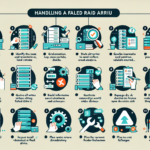Configuring RAID 10 for high write workloads requires careful planning and attention to best practices to ensure optimal performance, reliability, and scalability. RAID 10 combines the benefits of RAID 1 (mirroring) and RAID 0 (striping), making it ideal for workloads requiring high I/O performance and data redundancy. Here are the best practices:
1. Select Enterprise-Grade Disks
- Use high-performance, enterprise-grade SSDs or HDDs designed for high write workloads. SSDs generally offer better write speeds and are preferred for intensive workloads.
- Ensure all disks in the RAID array have similar capacity, speed, and specifications.
2. Optimize the Number of Disks
- RAID 10 requires a minimum of 4 disks (two mirrored pairs). For higher performance, scale up the number of disks as needed.
- More disks in a RAID 10 array increase throughput due to parallelism but ensure proper balancing between cost and performance.
3. Use a High-Performance RAID Controller
- Select a hardware RAID controller with sufficient cache (battery-backed or flash-backed write cache) to accelerate write operations.
- Ensure the RAID controller supports RAID 10 and has optimized algorithms for handling mirrored and striped arrays.
- Update firmware and drivers for the controller regularly for improved performance and reliability.
4. Enable Write Caching
- Configure write caching on the RAID controller or disks to enhance write speeds. Ensure the cache is battery-backed or protected to prevent data loss during power failures.
- For SSDs, ensure the drives support TRIM and garbage collection to maintain write performance over time.
5. Align Disk Partition Properly
- Align disk partitions to the stripe size of the RAID array to prevent misaligned I/O, which can degrade performance.
- Use tools or utilities to configure the alignment correctly (e.g.,
fdiskorpartedfor Linux systems).
6. Tune Stripe Size
- Choose an optimal stripe size based on the workload:
- Smaller stripe sizes are better for workloads with random writes (e.g., databases, OLTP).
- Larger stripe sizes are better for sequential writes (e.g., video streaming, backups).
- Test different stripe sizes to find the best balance for your specific workload.
7. Monitor Disk Health and Performance
- Implement monitoring tools to track disk health and RAID performance.
- Replace failing disks proactively to avoid degraded performance and potential data loss.
8. Separate Write-Intensive and Read-Intensive Workloads
- If possible, segregate write-intensive workloads to dedicated RAID arrays to avoid contention with read-heavy operations.
9. Plan for Redundancy and Spare Disks
- Configure hot spares in the RAID array to minimize downtime in case of disk failure.
- Ensure spare disks match the specifications of the disks in the RAID array.
10. Implement Backup and Disaster Recovery
- RAID is not a substitute for backups. Regularly back up data to an external storage system or cloud service to protect against logical corruption, accidental deletions, or catastrophic failures.
11. Regularly Test Write Performance
- Periodically test write performance using tools like
fio,Iometer, orhdparmto ensure the RAID configuration meets workload requirements. - Adjust settings (e.g., stripe size, caching) based on test results.
12. Consider RAID Alternatives for High Write Workloads
- If write performance is still insufficient, consider alternatives like RAID 5 or RAID 6 with SSDs, or software-defined storage solutions optimized for write-heavy workloads.
13. Use High-Speed Connectivity
- Ensure high-speed network interfaces (e.g., 10GbE, 25GbE) are used for accessing the RAID array in case of external storage solutions. Bottlenecks in connectivity can negate RAID performance benefits.
14. Virtualization and Application-Specific Optimization
- For virtualized environments, align virtual machine storage I/O workloads to the RAID array’s capabilities.
- Optimize applications (e.g., databases) to use RAID 10 efficiently by configuring appropriate I/O settings.
15. Test and Benchmark Before Production
- Before deploying RAID 10 into production, perform extensive testing and benchmarking under simulated workloads to validate performance and reliability.
By following these best practices, you can ensure RAID 10 is configured optimally for high write workloads, delivering the performance and redundancy required by demanding applications.



